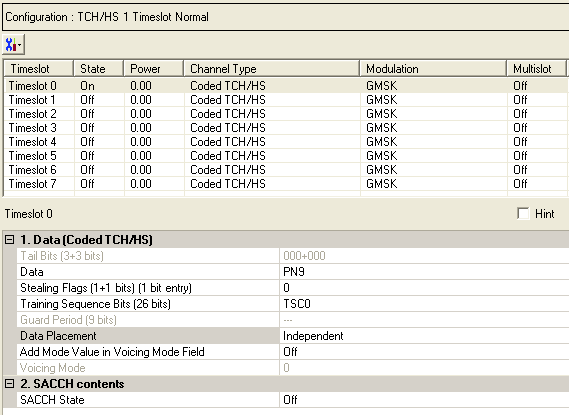
The TCH/HS is a coded channel that is available with Option QFP.To open the Data node, click Data in the tree view. Use the Data window to define the bits in the bursts. The cells displayed in the Data section are determined by the Channel Type for the selected timeslot as defined in the Timeslot window.
Figure: Coded TCH/HS Data Node

|
1. Data (Normal GMSK Burst) |
2. SACCH Contents |
|---|---|
|
|
|
|
|
|
|
|
|
|
|
|
|
|
Click  to display a drop-down menu in which you can copy a timeslot configuration
from one timeslot to another.
to display a drop-down menu in which you can copy a timeslot configuration
from one timeslot to another.
Use the Data window to define the bits in the bursts. The cells displayed in the Data section are determined by the burst type (Timeslot Type) for the selected timeslot as defined in the Timeslots window. In the window shown above, Timeslots 0 thru 7 are set up as data cells with a coded Traffic Channel Half Rate Speech (TCH/HS) burst.
Tail bits are set by the software. This cell is not editable.
Choice: PN9 |PN15 | User Defined Bits
Default: PN9
Click the Details button  in this cell to open the
in this cell to open the  Data Source
Selection
window.
Data Source
Selection
window.
Select an encoded , or . The selected data is coded continuously across the RLC data block per the 3GPP standards. An independent version of the selected data is coded across the MAC header.
To perform a receiver test with a continuous PN sequence, select .
You can enter 1 (control channel burst) or 0 (data channel burst). The default is 0.
Default: TSCO
Click the Details button  in this cell to open the
in this cell to open the  Data Source Selection
window.
Data Source Selection
window.
Select to or to use for the training sequence bits.
The training sequences selections are defined as follows:
If you manually change a timeslot (channel type), the training sequence for that timeslot resets to provided that the training sequence was not previously changed for the new channel type.
|
TSC0 |
0970897 |
|
TSC1 |
0B778B7 |
|
TSC2 |
10EE90E |
|
TSC3 |
11ED11E |
|
TSC4 |
06B906B |
|
TSC5 |
13AC13A |
|
TSC6 |
29F629F |
|
TSC7 |
3BC4BBC |
Select to define  custom training sequence
bits.
custom training sequence
bits.
Guard period bits are set by the software. This cell is not editable.
Figure: Guard Period Lengths Between Different Timeslots
|
Burst Transition |
Burst Transition Guard Period Between Timeslots (In terms of normal symbol periods) |
|
|---|---|---|
|
TS0 and TS1 or TS4 and TS5 |
Any other timeslot pair |
|
|
normal symbol period to normal symbol period |
9 |
8 |
Choice: Independent | Consecutive Data with Rearranging | Consecutive Data without Rearranging
Default: Independent
Double-click or use the drop-down menu to set the
 data placement type.
Refer to 3GPP TS 45.003-600, section 3.1 and Table 2; and 3GPP TS 46.010,
sections 3.1.1 to 3.1.4.
data placement type.
Refer to 3GPP TS 45.003-600, section 3.1 and Table 2; and 3GPP TS 46.010,
sections 3.1.1 to 3.1.4.
Choice: On | Off
Default: Off
Double-click or use the drop-down menu to set the state of the Add Mode Value in Voicing Mode Field.
Choice: 0 | 1 | 2 | 3
Default: 0
Double-click or use the drop-down menu to set the voicing mode type.
Choice: On | Off
Default: Off
Double-click or use the drop-down menu to set the channel state. If state is On, GMSK burst shall be used; If the state is Off, Dummy burst shall be used.
Tail bits are set by the software. This cell is not editable.
Choice: Valid | Invalid
Default: Valid
If Invalid is selected, a wrong CRC (cycle redundancy check) will be generated, so that Mobile Station (MS) cannot decode the SACCH correctly.
Choice: STD | PN9 | PN15 | User Defined Bits
Default: STD
If the  data source
is STD (Standard), SACCH contents will be generated by the user settings.
data source
is STD (Standard), SACCH contents will be generated by the user settings.
Range: 0 to 31
Default: 15
Enter a value to set power control level.
Range: 0 to 255
Default: 0
Enter a value to set timing advance for Mobile Station (MS).
Choice: PN9 | PN15 | User Defined Bits
Default: PN9
This is the content of the  21 octets
field in downlink SACCH block structure.
21 octets
field in downlink SACCH block structure.
SACCH spare bit is always 0. This cell is not editable.
SACCH SR0 bit is always 0. This cell is not editable.
SACCH FPC_EPC bit is always 0. This cell is not editable.
Stealing Flag for SACCH. It is always 1. This cell is not editable.
Choice: TSC0 to TSC7 or User Defined Bits
Default: TSC0
Select TSC0 to TSC7 or User Defined Bits to use for the training sequence bits.
The training sequences are defined as follows:
TSC0: 0970897
TSC1: 0B778B7
TSC2: 10EE90E
TSC3: 11ED11E
TSC4: 06B906B
TSC5: 13AC13A
TSC6: 29F629F
TSC7: 3BC4BBC
The guard period bits are set by the software. This cell is not editable.